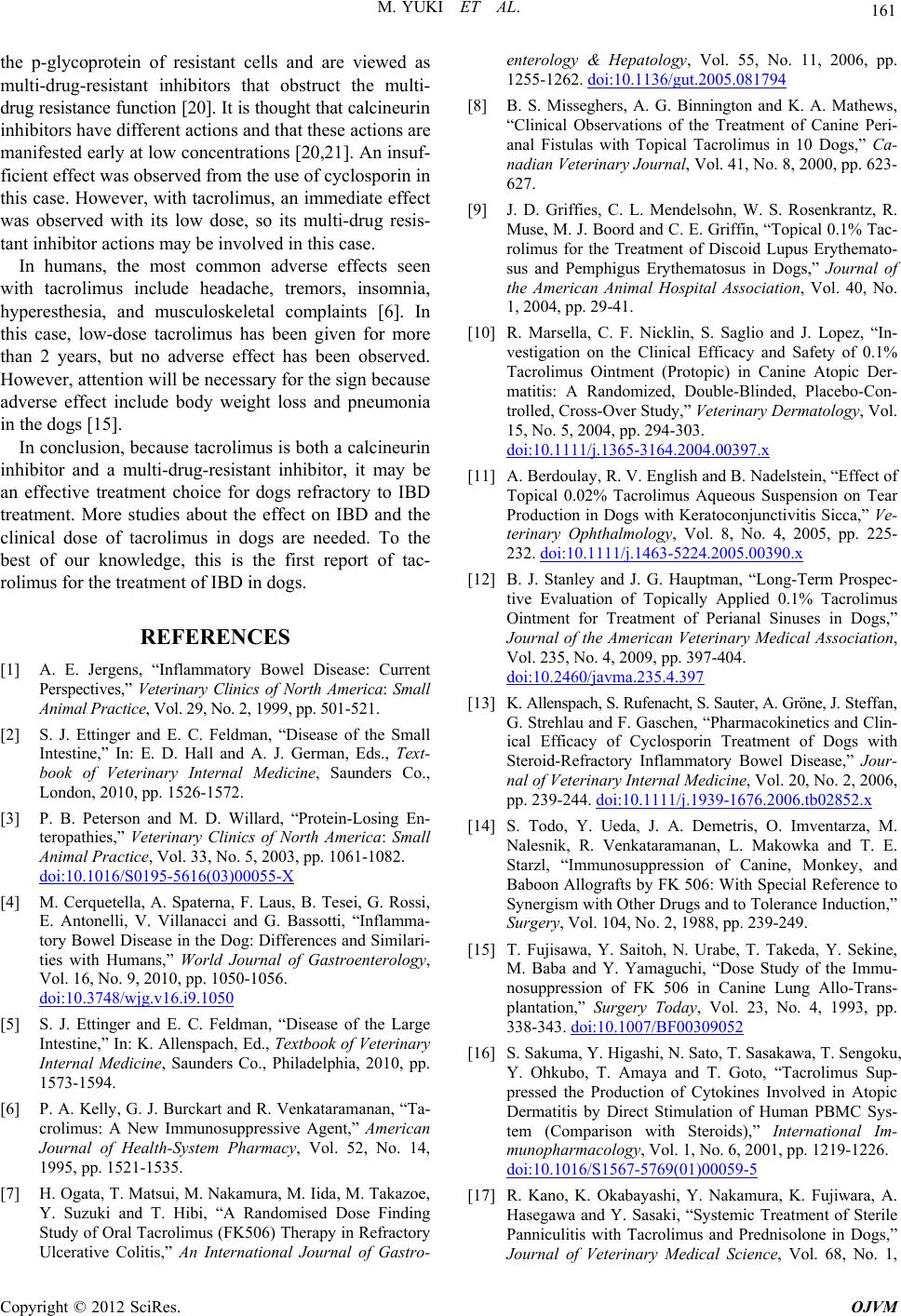
M. YUKI ET AL. 161
the p-glycoprotein of resistant cells and are viewed as
multi-drug-resistant inhibitors that obstruct the multi-
drug resistance function [20]. It is thought that calcineurin
inhibitors have different actions and that these actions are
manifested early at low concentrations [20,21]. An insuf-
ficient effect was observed from the use of cyclosporin in
this case. However, with tacrolimus, an immediate effect
was observed with its low dose, so its multi-drug resis-
tant inhibitor actions may be involved in this case.
In humans, the most common adverse effects seen
with tacrolimus include headache, tremors, insomnia,
hyperesthesia, and musculoskeletal complaints [6]. In
this case, low-dose tacrolimus has been given for more
than 2 years, but no adverse effect has been observed.
However, attention will be necessary for the sign because
adverse effect include body weight loss and pneumonia
in the dogs [15].
In conclusion, because tacrolimus is both a calcineurin
inhibitor and a multi-drug-resistant inhibitor, it may be
an effective treatment choice for dogs refractory to IBD
treatment. More studies about the effect on IBD and the
clinical dose of tacrolimus in dogs are needed. To the
best of our knowledge, this is the first report of tac-
rolimus for the treatment of IBD in dogs.
REFERENCES
[1] A. E. Jergens, “Inflammatory Bowel Disease: Current
Perspectives,” Veterinary Clinics of North America: Small
Animal Practice, Vol. 29, No. 2, 1999, pp. 501-521.
[2] S. J. Ettinger and E. C. Feldman, “Disease of the Small
Intestine,” In: E. D. Hall and A. J. German, Eds., Text-
book of Veterinary Internal Medicine, Saunders Co.,
London, 2010, pp. 1526-1572.
[3] P. B. Peterson and M. D. Willard, “Protein-Losing En-
teropathies,” Veterinary Clinics of North America: Small
Animal Practice, Vol. 33, No. 5, 2003, pp. 1061-1082.
doi:10.1016/S0195-5616(03)00055-X
[4] M. Cerquetella, A. Spaterna, F. Laus, B. Tesei, G. Rossi,
E. Antonelli, V. Villanacci and G. Bassotti, “Inflamma-
tory Bowel Disease in the Dog: Differences and Similari-
ties with Humans,” World Journal of Gastroenterology,
Vol. 16, No. 9, 2010, pp. 1050-1056.
doi:10.3748/wjg.v16.i9.1050
[5] S. J. Ettinger and E. C. Feldman, “Disease of the Large
Intestine,” In: K. Allenspach, Ed., Textbook of Veterinary
Internal Medicine, Saunders Co., Philadelphia, 2010, pp.
1573-1594.
[6] P. A. Kelly, G. J. Burckart and R. Venkataramanan, “Ta-
crolimus: A New Immunosuppressive Agent,” American
Journal of Health-System Pharmacy, Vol. 52, No. 14,
1995, pp. 1521-1535.
[7] H. Ogata, T. Matsui, M. Nakamura, M. Iida, M. Takazoe,
Y. Suzuki and T. Hibi, “A Randomised Dose Finding
Study of Oral Tacrolimus (FK506) Therapy in Refractory
Ulcerative Colitis,” An International Journal of Gastro-
enterology & Hepatology, Vol. 55, No. 11, 2006, pp.
1255-1262. doi:10.1136/gut.2005.081794
[8] B. S. Misseghers, A. G. Binnington and K. A. Mathews,
“Clinical Observations of the Treatment of Canine Peri-
anal Fistulas with Topical Tacrolimus in 10 Dogs,” Ca-
nadian Veterinary Journal, Vol. 41, No. 8, 2000, pp. 623-
627.
[9] J. D. Griffies, C. L. Mendelsohn, W. S. Rosenkrantz, R.
Muse, M. J. Boord and C. E. Griffin, “Topical 0.1% Tac-
rolimus for the Treatment of Discoid Lupus Erythemato-
sus and Pemphigus Erythematosus in Dogs,” Journal of
the American Animal Hospital Association, Vol. 40, No.
1, 2004, pp. 29-41.
[10] R. Marsella, C. F. Nicklin, S. Saglio and J. Lopez, “In-
vestigation on the Clinical Efficacy and Safety of 0.1%
Tacrolimus Ointment (Protopic) in Canine Atopic Der-
matitis: A Randomized, Double-Blinded, Placebo-Con-
trolled, Cross-Over Study,” Veterinary Dermatology, Vol.
15, No. 5, 2004, pp. 294-303.
doi:10.1111/j.1365-3164.2004.00397.x
[11] A. Berdoulay, R. V. English and B. Nadelstein, “Effect of
Topical 0.02% Tacrolimus Aqueous Suspension on Tear
Production in Dogs with Keratoconjunctivitis Sicca,” Ve-
terinary Ophthalmology, Vol. 8, No. 4, 2005, pp. 225-
232. doi:10.1111/j.1463-5224.2005.00390.x
[12] B. J. Stanley and J. G. Hauptman, “Long-Term Prospec-
tive Evaluation of Topically Applied 0.1% Tacrolimus
Ointment for Treatment of Perianal Sinuses in Dogs,”
Journal of the American Veterinary Medical Association,
Vol. 235, No. 4, 2009, pp. 397-404.
doi:10.2460/javma.235.4.397
[13] K. Allenspach, S. Rufenacht, S. Sauter, A. Gröne, J. Steffan,
G. Strehlau and F. Gaschen, “Pharmacokinetics and Clin-
ical Efficacy of Cyclosporin Treatment of Dogs with
Steroid-Refractory Inflammatory Bowel Disease,” Jour-
nal of Veterinary Internal Medicine, Vol. 20, No. 2, 2006,
pp. 239-244. doi:10.1111/j.1939-1676.2006.tb02852.x
[14] S. Todo, Y. Ueda, J. A. Demetris, O. Imventarza, M.
Nalesnik, R. Venkataramanan, L. Makowka and T. E.
Starzl, “Immunosuppression of Canine, Monkey, and
Baboon Allografts by FK 506: With Special Reference to
Synergism with Other Drugs and to Tolerance Induction,”
Surgery, Vol. 104, No. 2, 1988, pp. 239-249.
[15] T. Fujisawa, Y. Saitoh, N. Urabe, T. Takeda, Y. Sekine,
M. Baba and Y. Yamaguchi, “Dose Study of the Immu-
nosuppression of FK 506 in Canine Lung Allo-Trans-
plantation,” Surgery Today, Vol. 23, No. 4, 1993, pp.
338-343. doi:10.1007/BF00309052
[16] S. Sakuma, Y. Higashi, N. Sato, T. Sasakawa, T. Sengoku,
Y. Ohkubo, T. Amaya and T. Goto, “Tacrolimus Sup-
pressed the Production of Cytokines Involved in Atopic
Dermatitis by Direct Stimulation of Human PBMC Sys-
tem (Comparison with Steroids),” International Im-
munopharmacology, Vol. 1, No. 6, 2001, pp. 1219-1226.
doi:10.1016/S1567-5769(01)00059-5
[17] R. Kano, K. Okabayashi, Y. Nakamura, K. Fujiwara, A.
Hasegawa and Y. Sasaki, “Systemic Treatment of Sterile
Panniculitis with Tacrolimus and Prednisolone in Dogs,”
Journal of Veterinary Medical Science, Vol. 68, No. 1,
Copyright © 2012 SciRes. OJVM